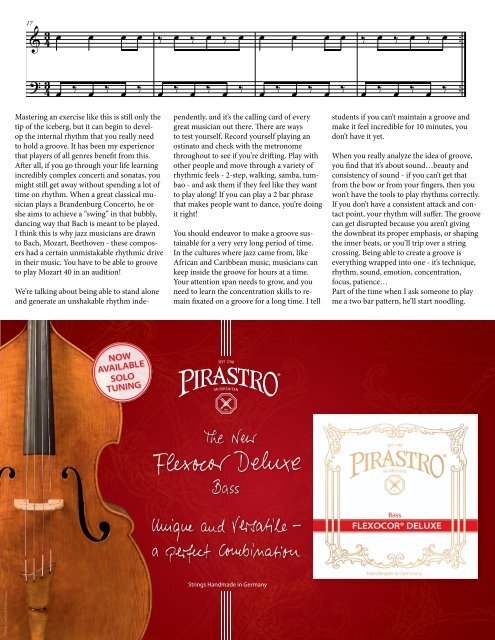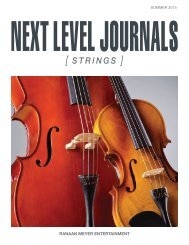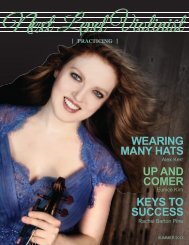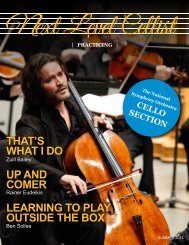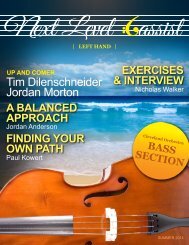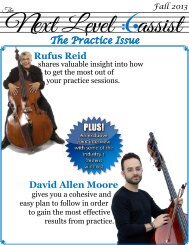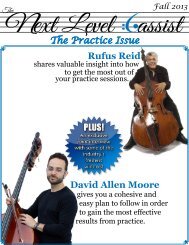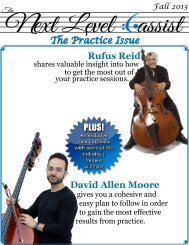Next Level Bassist Musicality Issue
Articles by Sarah Hogan and John Patitucci, Spotlight on the Pittsburgh Symphony, Double Stop Strum by Ranaan Meyer
Articles by Sarah Hogan and John Patitucci, Spotlight on the Pittsburgh Symphony, Double Stop Strum by Ranaan Meyer
You also want an ePaper? Increase the reach of your titles
YUMPU automatically turns print PDFs into web optimized ePapers that Google loves.
17<br />
&<br />
4 3 œ œ œ œ ‰ œ ‰ œ ‰ œ œ œ œ œ ‰ œ ‰ œ ‰ œ .<br />
4 3<br />
?<br />
œ ‰ œ ‰ œ ‰<br />
œ ‰ œ ‰ œ ‰<br />
œ ‰ œ ‰ œ ‰<br />
œ ‰ œ ‰ œ ‰<br />
.<br />
Mastering an exercise like this is still only the<br />
tip of the iceberg, but it can begin to develop<br />
the internal rhythm that you really need<br />
to hold a groove. It has been my experience<br />
that players of all genres benefit from this.<br />
After all, if you go through your life learning<br />
incredibly complex concerti and sonatas, you<br />
might still get away without spending a lot of<br />
time on rhythm. When a great classical musician<br />
plays a Brandenburg Concerto, he or<br />
she aims to achieve a “swing” in that bubbly,<br />
dancing way that Bach is meant to be played.<br />
I think this is why jazz musicians are drawn<br />
to Bach, Mozart, Beethoven - these composers<br />
had a certain unmistakable rhythmic drive<br />
in their music. You have to be able to groove<br />
to play Mozart 40 in an audition!<br />
We’re talking about being able to stand alone<br />
and generate an unshakable rhythm independently,<br />
and it’s the calling card of every<br />
great musician out there. There are ways<br />
to test yourself. Record yourself playing an<br />
ostinato and check with the metronome<br />
throughout to see if you’re drifting. Play with<br />
other people and move through a variety of<br />
rhythmic feels - 2-step, walking, samba, tumbao<br />
- and ask them if they feel like they want<br />
to play along! If you can play a 2 bar phrase<br />
that makes people want to dance, you’re doing<br />
it right!<br />
You should endeavor to make a groove sustainable<br />
for a very very long period of time.<br />
In the cultures where jazz came from, like<br />
African and Caribbean music, musicians can<br />
keep inside the groove for hours at a time.<br />
Your attention span needs to grow, and you<br />
need to learn the concentration skills to remain<br />
fixated on a groove for a long time. I tell<br />
students if you can’t maintain a groove and<br />
make it feel incredible for 10 minutes, you<br />
don’t have it yet.<br />
When you really analyze the idea of groove,<br />
you find that it’s about sound…beauty and<br />
consistency of sound - if you can’t get that<br />
from the bow or from your fingers, then you<br />
won’t have the tools to play rhythms correctly.<br />
If you don’t have a consistent attack and contact<br />
point, your rhythm will suffer. The groove<br />
can get disrupted because you aren’t giving<br />
the downbeat its proper emphasis, or shaping<br />
the inner beats, or you’ll trip over a string<br />
crossing. Being able to create a groove is<br />
everything wrapped into one - it’s technique,<br />
rhythm, sound, emotion, concentration,<br />
focus, patience…<br />
Part of the time when I ask someone to play<br />
me a two bar pattern, he’ll start noodling.<br />
NOW<br />
AVAILABLE<br />
SOLO<br />
TUNING<br />
Strings Handmade in Germany<br />
Photo Credit © Pöllmann<br />
14 NOV/DEC 2013 NEXT LEVEL BASSIST


